California's congressional districts
California is the most populous U.S. state and as a result has the most representation in the United States House of Representatives, with 53 Representatives. Each Representative represents one congressional district.
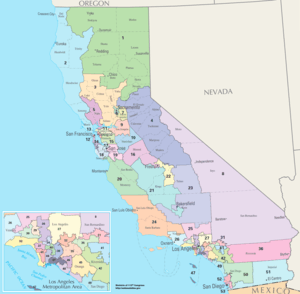
1992: Court ordered districts
The 1990 census gave California seven additional congressional seats. Attempts by the legislature to draw up new districts were unsuccessful, as three different plans drawn up by the Democratic-controlled Legislature were vetoed by Republican governor Pete Wilson. In September 1991 the California Supreme Court took jurisdiction over the redistricting process to break the stalemate.[1][2] Districts were drawn up by a panel of retired judges.
2002: Bipartisan redistricting
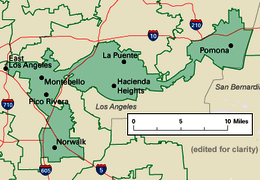
After the 2000 census, the California State Legislature was obliged to complete redistricting[3] for House of Representatives districts (in accordance with Article 1, Section 4 of the United States Constitution) as well as California State Assembly and California State Senate districts. It was mutually decided by legislators that the status quo in terms of balance of power would be preserved - a so-called Incumbent Protection Plan.[4] A bipartisan gerrymandering effort was done, and districts were configured in such a way that they were dominated by one or the other party, with few districts that could be considered competitive. In some cases this resulted in extremely convoluted boundary lines.
In the 2004 elections, a win by less than 55 percent of the vote was quite rare. This was seen in only five out of 80 State Assembly seats and two out of 20 State Senate seats up for election. The congressional seats were even less competitive than the state legislative districts - just three of the 53 districts were won with less than 60 percent of the vote in 2004.
2012: Citizens Redistricting Commission
Proposition 11, a California ballot proposition known as the Voters FIRST Act, was approved by the voters on November 4, 2008. It removed from the California Legislature the responsibility for drawing the state's congressional districts, and gave the responsibility instead to a 14-member Citizens Commission.[5] The U.S. Supreme Court upheld the constitutionality of removing the responsibility from the legislature. The proposition also required that the districts drawn up (1) comply with the federal Voting Rights Act; (2) make districts contiguous; (3) respect, to the extent possible, the integrity of cities, counties, neighborhoods and "communities of interest"; and (4) to the extent possible, make districts compact. Several of these terms are not defined in law.
Governor Arnold Schwarzenegger had earlier proposed placing the redistricting process in the hands of retired judges, which was on the November ballot as an initiative in a special election (called by the Governor on June 14, 2005), Proposition 77. The special election was held on November 8, 2005. However, the initiative was overwhelmingly defeated, with 59 percent voting no. All initiatives, including those proposed by the Governor's allies and several independent initiatives, failed that year.
The California Citizens Redistricting Commission certified final district maps on August 15, 2011, and they took effect with the 2012 election.[6] The new districts are described as more "purple" than "red" or "blue" - that is, more mixed in electoral composition compared to the mostly "safe" districts of the previous decade, where incumbents were almost guaranteed re-election. These new districts, combined with demographic trends over several decades that favored the Democratic party, resulted in a gain of four House of Representatives seats for California Democrats in the 2012 elections.
Current districts and representatives
List of members of the California United States House delegation, their terms in office, district boundaries, and their political ratings according to the CPVI. The delegation for the 116th Congress has a total of 53 members, with 45 Democrats (including Speaker of the House Nancy Pelosi) and 7 Republicans (including minority leader Kevin McCarthy). This represents an increase in the Democrats' hold on California from the preceding 115th Congress; in the 2018 elections, Democrats were elected in 7 previously Republican-held seats. in May 2020, Republican Mike Garcia won the 25th district special election to succeed Democrat Katie Hill increasing Republican's seat total by 1. One seat is vacant since the resignation of Republican Duncan D. Hunter on January 13, 2020.
| District | Representative | Party | CPVI | Incumbent time in office | District map |
|---|---|---|---|---|---|
| 1st | 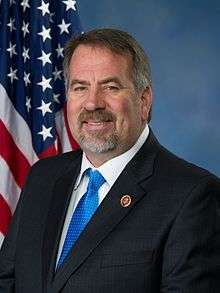 |
Republican | R+11 | January 3, 2013 – present | .tif.png) |
| 2nd |  |
Democratic | D+22 | January 3, 2013 – present | .tif.png) |
| 3rd |  |
Democratic | D+5 | November 3, 2009 – present | .tif.png) |
| 4th | Republican | R+10 | January 3, 2009 – present | .tif.png) | |
| 5th |  |
Democratic | D+21 | January 3, 1999 – present | .tif.png) |
| 6th | Democratic | D+21 | March 10, 2005 – present | .tif.png) | |
| 7th | .jpg) |
Democratic | D+3 | January 3, 2013 – present | .tif.png) |
| 8th |  |
Republican | R+9 | January 3, 2013 – present | .tif.png) |
| 9th | .jpg) |
Democratic | D+8 | January 3, 2007 – present | .tif.png) |
| 10th | 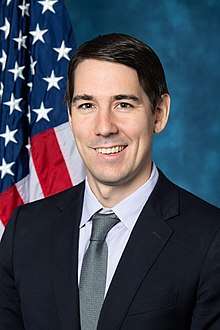 |
Democratic | EVEN | January 3, 2019 - present | .tif.png) |
| 11th |  |
Democratic | D+21 | January 3, 2015 – present | .tif.png) |
| 12th |  |
Democratic | D+37 | June 2, 1987 – present | .tif.png) |
| 13th | 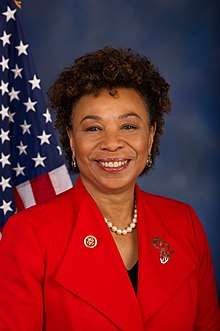 |
Democratic | D+40 | April 21, 1998 – present | .tif.png) |
| 14th | .jpg) |
Democratic | D+27 | April 8, 2008 – present | .tif.png) |
| 15th | .jpg) |
Democratic | D+20 | January 3, 2013 – present | .tif.png) |
| 16th | .jpg) |
Democratic | D+9 | January 3, 2005 – present | .tif.png) |
| 17th |  |
Democratic | D+25 | January 3, 2017 – present | .tif.png) |
| 18th | 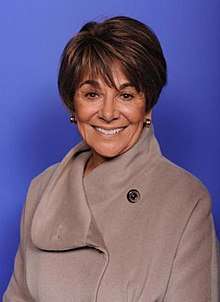 |
Democratic | D+23 | January 3, 1993 – present | .tif.png) |
| 19th |  |
Democratic | D+24 | January 3, 1995 – present | .tif.png) |
| 20th |  |
Democratic | D+23 | January 3, 2017 – present | .tif.png) |
| 21st | 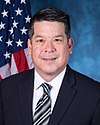 |
Democratic | D+5 | January 3, 2019 - present | .tif.png) |
| 22nd | .jpg) |
Republican | R+8 | January 3, 2003 – present | .tif.png) |
| 23rd | 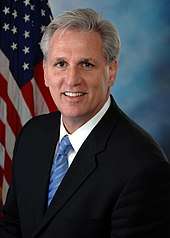 |
Republican | R+14 | January 3, 2007 – present | .tif.png) |
| 24th | .jpg) |
Democratic | D+7 | January 3, 2017 – present | .tif.png) |
| 25th | .jpg) |
Republican | EVEN | May 19, 2020 - present | .tif.png) |
| 26th | 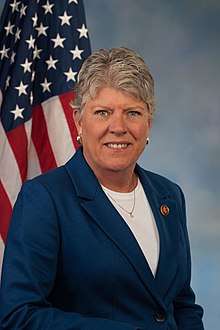 |
Democratic | D+7 | January 3, 2013 – present | .tif.png) |
| 27th | .jpg) |
Democratic | D+16 | July 14, 2009 – present | .tif.png) |
| 28th | .jpg) |
Democratic | D+23 | January 3, 2001 – present | .tif.png) |
| 29th | .jpg) |
Democratic | D+29 | January 3, 2013 – present | .tif.png) |
| 30th | 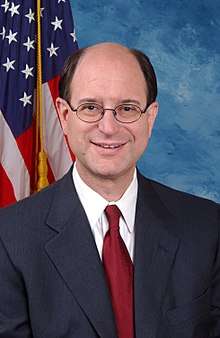 |
Democratic | D+18 | January 3, 1997 – present | .tif.png) |
| 31st |  |
Democratic | D+8 | January 3, 2015 – present | .tif.png) |
| 32nd | 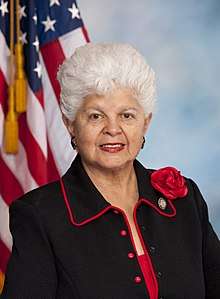 |
Democratic | D+17 | January 3, 1999 – present | .tif.png) |
| 33rd |  |
Democratic | D+16 | January 3, 2015 – present | .tif.png) |
| 34th | .jpg) |
Democratic | D+35 | July 11, 2017 – present | .tif.png) |
| 35th |  |
Democratic | D+19 | January 3, 2015 – present | .tif.png) |
| 36th | 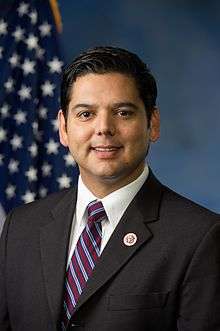 |
Democratic | D+2 | January 3, 2013 – present | .tif.png) |
| 37th |  |
Democratic | D+37 | January 3, 2011 – present | .tif.png) |
| 38th |  |
Democratic | D+17 | January 3, 2003 – present | .tif.png) |
| 39th |  |
Democratic | EVEN | January 3, 2019 - present | .tif.png) |
| 40th |  |
Democratic | D+33 | January 3, 1993 – present | .tif.png) |
| 41st | 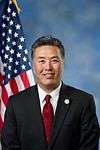 |
Democratic | D+12 | January 3, 2013 – present | .tif.png) |
| 42nd | 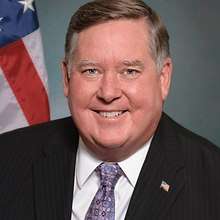 |
Republican | R+9 | January 3, 1993 – present | .tif.png) |
| 43rd | 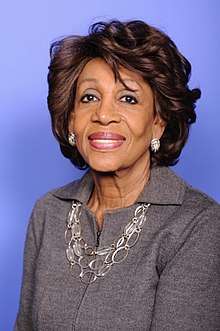 |
Democratic | D+29 | January 3, 1991 – present | .tif.png) |
| 44th | 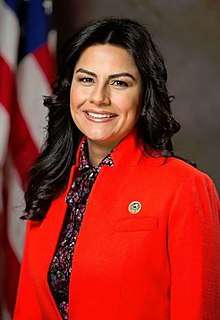 |
Democratic | D+35 | January 3, 2017 – present | .tif.png) |
| 45th | 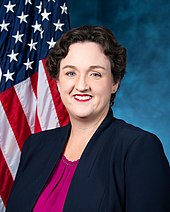 |
Democratic | R+3 | January 3, 2019 - present | .tif.png) |
| 46th | 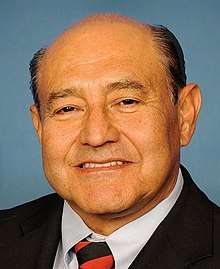 |
Democratic | D+15 | January 3, 2017 – present | .tif.png) |
| 47th |  |
Democratic | D+13 | January 3, 2013 – present | .tif.png) |
| 48th |  |
Democratic | R+4 | January 3, 2019 - present | .tif.png) |
| 49th | 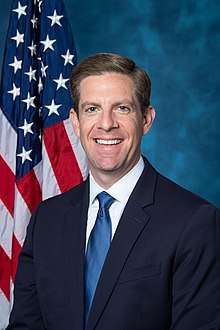 |
Democratic | R+1 | January 3, 2019 - present | .tif.png) |
| 50th | Vacant | R+11 | January 13, 2020 – present | .tif.png) | |
| 51st |  |
Democratic | D+22 | January 3, 2013 – present | .tif.png) |
| 52nd | 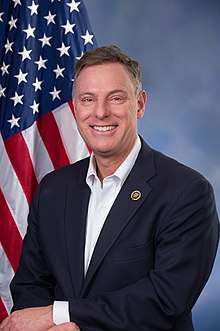 |
Democratic | D+6 | January 3, 2013 – present | .tif.png) |
| 53rd | 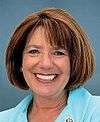 |
Democratic | D+14 | January 3, 2001 – present | .tif.png) |
Historical district boundaries
Districts from 2003–2013
References
- "Supreme Court takes over remapping job". Sacramento Bee. September 26, 1991. Retrieved September 3, 2011.
- "Court Remap Plan Could Cut Democrats' Clout in California". Washington Post. December 4, 1991. Retrieved September 3, 2011.
- The word "gerrymandering" is replaced with redistricting as the word "gerrymandering" refers, by definition, to the redrawing of districts to the advantage of a single party or for partisan gain
- "Latinos May Gain Few Seats in Redistricting; Politics: Their push for more representation in Congress clashes with Democrats' desire to protect incumbents as district boundaries are redrawn". Los Angeles Times. August 26, 2001. Retrieved September 5, 2011.
- "Citizens Commission website: background". Archived from the original on September 2, 2011. Retrieved September 3, 2011.
- "California Citizens Redistricting Commission | "Fair Representation - Democracy at Work!"".
